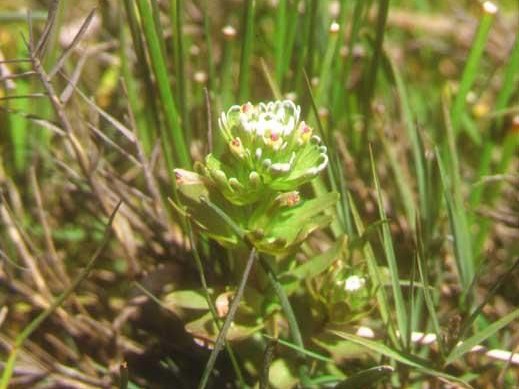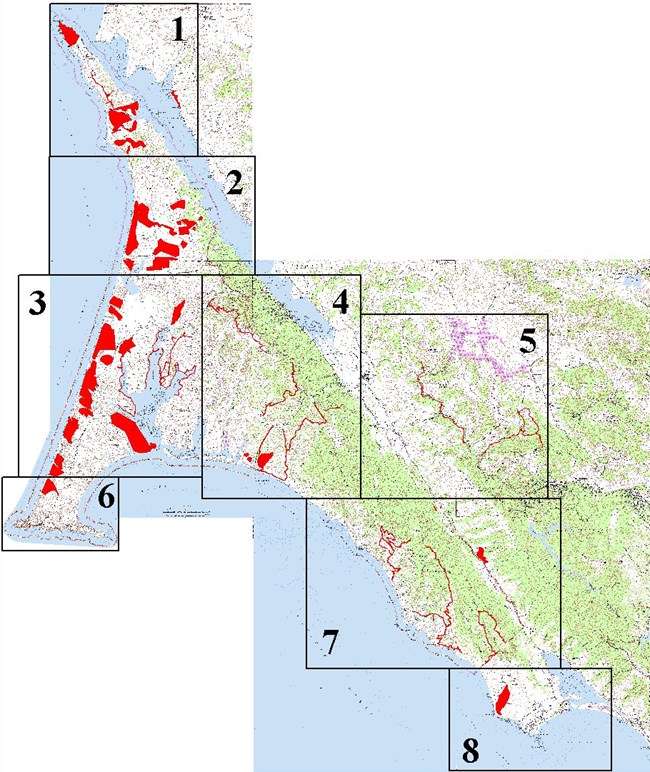Last updated: September 17, 2018
Article
Rare Plant Inventory for Point Reyes National Seashore

NPS
Importance
Point Reyes National Seashore hosts over 900 species of flowering plants, representing approximately 16% of the plant species known to occur in California. This diverse flora includes 48 rare plant species.
Successful management of rare species requires comprehensive information describing their abundance and distribution. Prior to 2001, this information was unknown or incomplete for many rare species within Point Reyes. In August of 2001, the California Native Plant Society published the sixth edition of their Inventory of Rare and Endangered Plants of California, and with it, a number of new species were added to the Seashore’s rare plant list. Around the same time, the park acquired a number of new land parcels that required detailed floristic surveys. In addition, nearly 20 years had passed since the last systematic rare plant survey (although California Native Plant Society volunteers had identified 146 new locations of rare plants over 18 years). Recognizing the need for a comprehensive survey, resource staff initiated the search for undocumented rare plant populations within the Seashore in 2001.

NPS
Inventory Methods
The National Park Service conducted rare plant field surveys between March and September of 2001 through 2004, timed to coincide with the blooming period of target species.
Prior to conducting field surveys, The National Park Service completed an assessment of all rare plants known, or with potential, to occur within the Seashore. Staff carefully reviewed plant occurrence records and developed a prioritized list of rare species. Habitats with potential to support rare species were identified using the park vegetation map, aerial photographs, and the past experience of California Native Plant Society members, local botanists, and resource management staff.
High-priority species included those with potential to occur within the Seashore, species newly listed in the California Native Plant Society's Sixth Inventory of Rare and Endangered Plants of California, federal or state listed species, species with little known information, and locally rare or “high-risk” species. High-priority areas included those not visited before, newly acquired land parcels, and areas with planned management activities. Park staff created schedules with all rare plants sorted by blooming period (month or season) and habitat type. Field surveys were then conducted by “sweeping” through the survey area and by focusing searches in areas that contained suitable habitat for target rare plants. Surveyors documented and mapped all rare plant occurrences they encountered using a standard data sheet and a GPS unit.
Resource managers also developed a “Rare-Plant-A-Thon” to involve the public in the search and to manage the task of surveying over 71,000 acres of potential habitat. Approximately 350 volunteers logged 2,300 volunteer hours identifying rare plants in six Rare-Plant-A-Thons conducted between 2001 and 2004.
Inventory Findings
Volunteers and staff documented and mapped 145 previously unrecorded rare plant populations (Table 1). These brought the total number of rare plant populations in Point Reyes up to 435, an increase of 34%.
Two new rare species were added to the plant list: the Humboldt Bay owl’s clover (Castilleja ambigua ssp. humboldtiensis), which is listed by the California Native Plant Society, and coastal bluff morning glory (Calystegia purpurata ssp. saxicola). The Rare-Plant-A-Thons identified 67 of the new occurrences and one of the Point Reyes plant list additions. In total, National Parks Service staff and volunteers surveyed 4,346 acres (1,760 ha) of potential habitat during the inventory effort.
|
Species *federally endangered |
Common Name | Number of new occurrences |
|---|---|---|
| Abronia umbellata ssp. breviflora | Pink sand-verbena | 5 |
| Agrostis blasdalei | Blasdale's bentgrass | 4 |
| Alopecurus aequalis var. sonomensis* | Sonoma alopecurus | 1 |
| Arabis blepharophylla | Coast rock cress | 1 |
| Arctostaphylos virgata | Marin manzanita | 3 |
| Astragalus pycnostachyus var. pycnostachyus | Coastal marsh milk-vetch | 10 |
| Calystegia purpurata ssp. saxicola | Coastal bluff morning-glory | 7 |
| Castilleja ambigua ssp. humboldtiensis | Humboldt Bay owl's clover | 1 |
| Ceanothus gloriosus var. gloriosus | Point Reyes ceanothus | 2 |
| Cirsium andrewsii | Franciscan thistle | 4 |
| Cordylanthus maritimus ssp. palustris | Point Reyes bird's beak | 10 |
| Elymus californicus | California bottlebrush grass | 13 |
| Fritillaria affinis var. tristulis | Marin checker lily | 11 |
| Fritillaria liliaceae | Fragrant fritillary | 1 |
| Gilia capitata ssp. chamissonis | Dune gilia | 6 |
| Gilia millefoliata | Dark-eyed gilia | 6 |
| Grindelia hirsutula var. maritima | San Francisco gumplant | 2 |
| Hesperevax sparsiflora var. breviflora | Short-leaved evax | 1 |
| Lasthenia macrantha var. macrantha | Perennial goldfields | 6 |
| Layia carnosa* | Beach layia | 1 |
| Limnanthes douglasii ssp. sulphurea | Point Reyes meadowfoam | 1 |
| Linanthus rosaceus | Rosy linanthus | 11 |
| Lupinus tidestromii* | Tidestrom's lupine | 3 |
| Microseris paludosa | Marsh microseris | 2 |
| Perideridia gairdneri ssp. gairdneri | Gairdner's yampah | 2 |
| Polygonum marinense | Marin knotweed | 13 |
| Ranunculus lobbii | Lobb's aquatic buttercup | 5 |
| Sidalcea calycosa ssp. rhizomata | Point Reyes checkerbloom | 3 |
| Stellaria littoralis | Beach starwort | 5 |
| Triphysaria floribunda | San Francisco owl's clover | 5 |
| Total | 145 |
Additional Resources
Contact Information
Links
San Francisco Bay Area Inventory & Monitoring Network
Pacific Coast Science and Learning Center
San Francisco Bay Area Network Species Lists - Certified Species lists including residency, abundance, and native/non-native status.
California Native Plant Society
Plant Community Monitoring in the San Francisco Bay Area
Summary by Alison Williams, San Francisco Bay Area Inventory & Monitoring Network, April 2009.
Download PDF from the NPS Data Store
